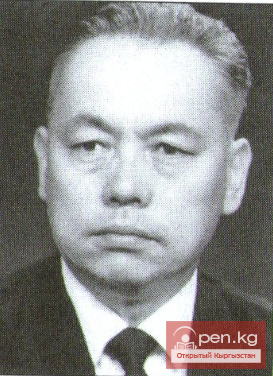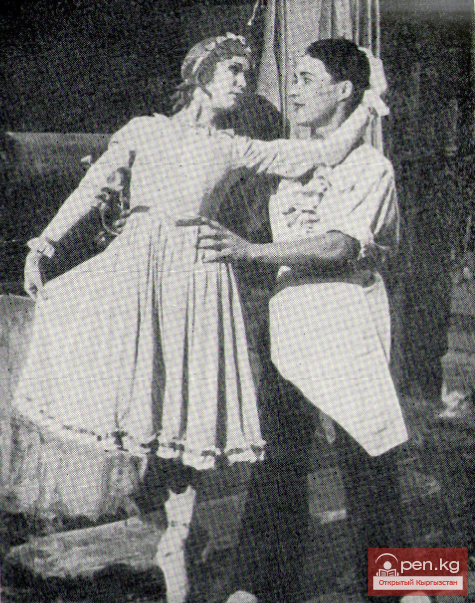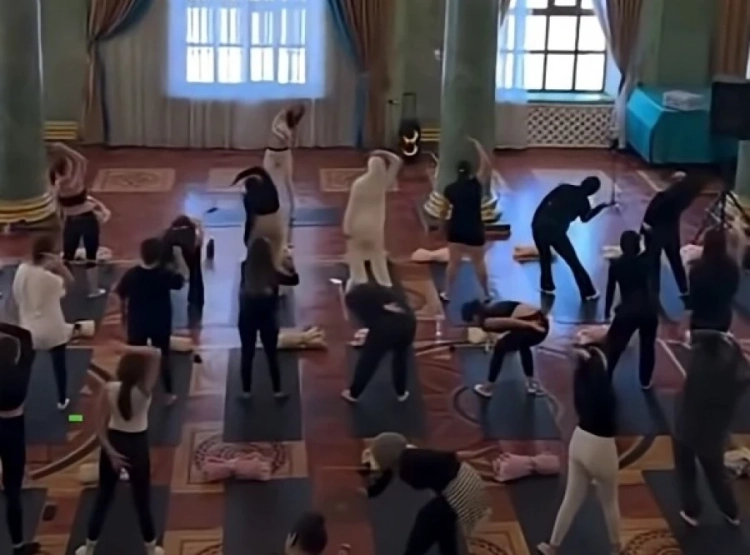National Operas
National opera performances occupy a significant place in the repertoire of the Kyrgyz State Opera and Ballet Theater.
Each of them includes both mass and solo dances. Thus, in the development of Kyrgyz ballet art, it is important to consider the contribution made by opera performances, especially since in most cases the overwhelming majority of the ballet troupe participates in them. Even a brief study of this issue is warranted, as the success of any opera performance depends on the quality of the ballet scenes.
On the stage of the Kyrgyz opera theater, national operas such as "Toktogul" by A. Veprik (1940), "Toktogul" by M. Abdrayev and A. Maldybaev (1956), "Toktogul" by V. Vlasov, A. Maldybaev, V. Fere (1958), "For the Happiness of the People" ("Frunze", I and II versions) by V. Vlasov, V. Fere, "Patriots" by V. Vlasov, A. Maldybaev, V. Fere, "Kokul" by M. Raukhverger, "Kim kantti" ("Who Did What") by A. Abdrayev, A. Amanbaev, A. Maldybaev, and A. Tuleev. "Manas" and "On the Shores of Issyk-Kul" by V. Vlasov, A. Maldybaev, V. Fere, "Aidar and Aisha" by A. Amanbaev, S. Germanov, "Young Hearts" by A. Abdrayev, "Akshumkar" by S. Ryauzov, "Murad" by A. Knipper, "Mother's Heart" by S. Germanov, "Oldjobay and Kishimjan" by M. Abdrayev.
In some operas, dances are organically woven into the action, while in others their supportive role is clearly felt. In both cases, the dances enrich the performance with the atmosphere of Kyrgyz life and customs. The dances in these operas are primarily characterized by plot-driven playful scenes.
As an example, let us consider some of the most typical dance numbers in Kyrgyz operas.
In 1943, A. Maldybaev, M. Abdrayev, A. Amanbaev, and A. Tuleev wrote the musical comedy "Kim kantti" on the theme of the heroic labor of Soviet people during the Great Patriotic War. There is a love intrigue: two young men love the same girl; one of them is a lazy good-for-nothing, while the other, although a good worker, is very shy, which prevents him from confessing his feelings to his beloved. Small dance numbers introduced into the action were connected to this romantic line. At the end of the first act, during a break, the youth initiates a mass dance. At first, it has a casual character and is accompanied by scherzo-like music. Then follows a small lyrical scene in which the shy Anarbek unsuccessfully tries to express his feelings to Salyy, while his friends harmlessly tease him. The playful scene ends with a joyful collective dance.
The second dance is related to the labor victory of the collective farmers. The beginning expresses general joy, the middle is filled with a performance by a women's group, and in conclusion, the dance again takes on a mass character (all dances are accompanied by a three-part choir).
As we can see, the dances reflect two of the most essential moments of the action — the relationships of the characters and the joy of labor successes — and therefore successfully fulfill their intended function of enhancing the emotional impact of the drama.
In the opera "Young Hearts" by Mukash Abdrayev, the dances are limited to two numbers in the first act. The action takes place in a Kyrgyz aiyl. At the call of the bashkarm (chairman of the collective farm), the people gather. While waiting for his arrival, the youth initiates a waltz-like dance.
The bashkarm arrives and announces the start of canal construction. The choir sings. The song has a calling character. In the rhythm of the song, a new collective dynamic dance begins to the tune of the Kyrgyz folk song "Kimge aitam?" ("To Whom Shall I Tell?"). In the second act of the opera "Young Hearts," there is no dance, but the music seems to ask for a dance embodiment. The choir sings a song about labor. In time with it, people work.
In the opera "Ak-Shumkar" by S. Ryauzov, we encounter weakened dance action. In the second scene, a small sketch resembles more of a dance accompaniment than a dance. To a Kyrgyz melody, the girls depict a folk game reminiscent of "Shakek Salmay." In the third scene, the dance also has a conditional character of a playful scene. Its content boils down to the following: during a break, two short soldiers tease their tall comrade. And together they mock the fourth — the careless and lazy one. The jokes were not malicious and were characterized by cheerfulness. In the music, one could feel the fusion of Russian and Kyrgyz melodies.
This scene, staged by K. Madevilova, delighted with good taste and infected with its liveliness. However, it generally appeared as an insert in the opera performance, having no impact on the development of the action.
Even less significant are the dance moments in the opera "Murad" by L. Knipper. In fact, there are almost none. In the last scene of the opera, a dance-game of a pantomime, humorous nature is introduced. The lead puts on a beard, and each time he appears, the girls fearfully scatter. This happens with the accompaniment of a choir singing the song "Sakalym-sakalym" ("Beard-Beard").
The authors of this production pay more than a modest tribute to the dance art. The opera turned out to be impoverished in dance music.
Choreography and Design in the Ballet "Kuyruchuk"














































